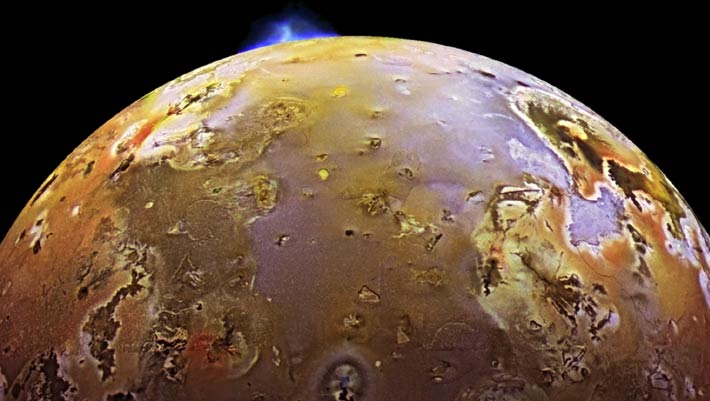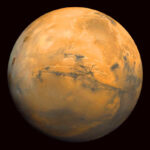These bright (hot) ‘thermal rings’ are a common phenomenon, and they are indicative of active lava lakes, according to a new analysis of data from the Jovian Infrared Auroral Mapper (JIRAM) instrument on NASA’s Juno spacecraft.
Visible maps, infrared radiance maps and temperature maps for Loki Patera and Dazhbog Patera. Image credit: Mura et al., doi: 10.1038/s43247-024-01486-5.
Io is the innermost of the four Galilean moons of Jupiter and the fourth-largest moon in our Solar System.
Aside from Earth, it is the only known place in the Solar System with volcanoes erupting hot lava like that on our planet.
Io has more than 400 active volcanoes, which are caused by tidal heating, the result of gravitational forces from Jupiter and other Jovian moons.
While there are many theories on the types of volcanic eruptions across the moon’s surface, little supporting data exist.
In both May and October 2023, NASA’s Juno orbiter flew by Io, coming within about 35,000 km (21,700 miles) and 13,000 km (8,100 miles), respectively.
Among Juno’s instruments getting a good look at the beguiling moon was JIRAM.
Designed to capture the infrared light emerging from deep inside Jupiter, JIRAM probes the weather layer down to 50-70 km (30-45 miles) below the gas giant’s cloud tops.
But during Juno’s extended mission, the mission team has also used the instrument to study the moons Io, Europa, Ganymede, and Callisto.
The JIRAM images of Io showed the presence of bright rings surrounding the floors of numerous hot spots.
“The high spatial resolution of JIRAM’s infrared images, combined with the favorable position of Juno during the flybys, revealed that the whole surface of Io is covered by lava lakes contained in caldera-like features,” said Juno co-investigator Dr. Alessandro Mura, a researcher at the National Institute for Astrophysics in Rome.
“In the region of Io’s surface in which we have the most complete data, we estimate about 3% of it is covered by one of these molten lava lakes. A caldera is a large depression formed when a volcano erupts and collapses.”

This image from NASA’s Galileo spacecraft shows a volcanic explosion on Io. Image credit: NASA / JPL / University of Arizon.
JIRAM’s flyby data not only highlight abundant lava reserves on Io, but also provides a glimpse of what may be going on below the surface.
Infrared images of several Io lava lakes show a thin circle of lava at the border, between the central crust that covers most of the lava lake and the lake’s walls.
Recycling of melt is implied by the lack of lava flows on and beyond the rim of the lake, indicating that there is a balance between melt that has erupted into the lava lakes and melt that is circulated back into the subsurface system.
“We now have an idea of what is the most frequent type of volcanism on Io: enormous lakes of lava where magma goes up and down,” Dr. Mura said.
“The lava crust is forced to break against the walls of the lake, forming the typical lava ring seen in Hawaiian lava lakes.”
“The walls are likely hundreds of meters high, which explains why magma is generally not observed spilling out of the paterae — bowl-shaped features created by volcanism — and moving across the moon’s surface.”
JIRAM data suggest that most of the surface of these Io hot spots is composed of a rocky crust that moves up and down cyclically as one contiguous surface due to the central upwelling of magma.
In this hypothesis, because the crust touches the lake’s walls, friction keeps it from sliding, causing it to deform and eventually break, exposing lava just below the surface.
An alternative hypothesis remains in play: magma is welling up in the middle of the lake, spreading out and forming a crust that sinks along the rim of the lake, exposing lava.
“We are just starting to wade into the JIRAM results from the close flybys of Io in December 2023 and February 2024,” said Dr. Scott Bolton, principal investigator for Juno at the Southwest Research Institute.
“The observations show fascinating new information on Io’s volcanic processes.”
“Combining these new results with Juno’s longer-term campaign to monitor and map the volcanoes on Io’s never-before-seen north and south poles, JIRAM is turning out to be one of the most valuable tools to learn how this tortured world works.”
The findings appear in the journal Nature Communications.
_____
A. Mura et al. 2024. Hot rings on Io observed by Juno/JIRAM. Commun Earth Environ 5, 340; doi: 10.1038/s43247-024-01486-5




